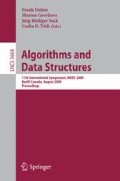Abstract
Cognitive experiments show that humans can read graph drawings in which all edge crossings are at right angles equally well as they can read planar drawings; they also show that the readability of a drawing is heavily affected by the number of bends along the edges. A graph visualization whose edges can only cross perpendicularly is called a RAC (Right Angle Crossing) drawing. This paper initiates the study of combinatorial and algorithmic questions related with the problem of computing RAC drawings with few bends per edge. Namely, we study the interplay between number of bends per edge and total number of edges in RAC drawings. We establish upper and lower bounds on these quantities by considering two classical graph drawing scenarios: The one where the algorithm can choose the combinatorial embedding of the input graph and the one where this embedding is fixed.
Access this chapter
Tax calculation will be finalised at checkout
Purchases are for personal use only
Preview
Unable to display preview. Download preview PDF.
References
Ackerman, E., Tardos, G.: On the maximum number of edges in quasi-planar graphs. J. Comb. Theory, Ser. A 114(3), 563–571 (2007)
Agarwal, P.K., Aronov, B., Pach, J., Pollack, R., Sharir, M.: Quasi-planar graphs have a linear number of edges. Combinatorica 17(1), 1–9 (1997)
Brightwell, G., Scheinerman, E.R.: Representations of planar graphs. SIAM J. Discrete Math. 6(2), 214–229 (1993)
Di Battista, G., Eades, P., Tamassia, R., Tollis, I.G.: Graph Drawing. Prentice Hall, Upper Saddle River (1999)
Felsner, S.: Triangles in euclidean arrangements. Discrete & Computational Geometry 22(3), 429–438 (1999)
Huang, W.: Using eye tracking to investigate graph layout effects. In: APVIS, pp. 97–100 (2007)
Huang, W.: An eye tracking study into the effects of graph layout. CoRR, abs/0810.4431 (2008)
Huang, W., Hong, S.-H., Eades, P.: Effects of crossing angles. In: PacificVis, pp. 41–46 (2008)
Jünger, M., Mutzel, P. (eds.): Graph Drawing Software. Springer, Heidelberg (2003)
Kaufmann, M., Wagner, D. (eds.): Drawing Graphs. Springer, Heidelberg (2001)
Nishizeki, T., Rahman, M.S.: Planar Graph Drawing. World Scientific, Singapore (2004)
Pach, J.: Geometric graph theory. In: Handbook of Discrete and Computational Geometry, pp. 219–238. CRC Press, Boca Raton (2004)
Pach, J., Radoicic, R., Tardos, G., Tóth, G.: Improving the crossing lemma by finding more crossings in sparse graphs. Discrete & Computational Geometry 36(4), 527–552 (2006)
Pach, J., Radoicic, R., Tóth, G.: Relaxing planarity for topological graphs. In: Akiyama, J., Kano, M. (eds.) JCDCG 2002. LNCS, vol. 2866, pp. 221–232. Springer, Heidelberg (2003)
Papakostas, A., Tollis, I.G.: Efficient orthogonal drawings of high degree graphs. Algorithmica 26(1), 100–125 (2000)
Purchase, H.C.: Effective information visualisation: a study of graph drawing aesthetics and algorithms. Interacting with Computers 13(2), 147–162 (2000)
Purchase, H.C., Carrington, D.A., Allder, J.-A.: Empirical evaluation of aesthetics-based graph layout. Empirical Software Engineering 7(3), 233–255 (2002)
Roudneff, J.-P.: The maximum number of triangles in arrangements of pseudolines. J. Comb. Theory, Ser. B 66(1), 44–74 (1996)
Tamassia, R., Tollis, I.G.: Planar grid embedding in linear time. IEEE Trans. Circuit Syst. CAS-36(9), 1230–1234 (1989)
Vignelli, M.: New york subway map, http://www.mensvogue.com/design/articles/2008/05/vignelli
Ware, C., Purchase, H.C., Colpoys, L., McGill, M.: Cognitive measurements of graph aesthetics. Information Visualization 1(2), 103–110 (2002)
Author information
Authors and Affiliations
Editor information
Editors and Affiliations
Rights and permissions
Copyright information
© 2009 Springer-Verlag Berlin Heidelberg
About this paper
Cite this paper
Didimo, W., Eades, P., Liotta, G. (2009). Drawing Graphs with Right Angle Crossings. In: Dehne, F., Gavrilova, M., Sack, JR., Tóth , C.D. (eds) Algorithms and Data Structures. WADS 2009. Lecture Notes in Computer Science, vol 5664. Springer, Berlin, Heidelberg. https://doi.org/10.1007/978-3-642-03367-4_19
Download citation
DOI: https://doi.org/10.1007/978-3-642-03367-4_19
Publisher Name: Springer, Berlin, Heidelberg
Print ISBN: 978-3-642-03366-7
Online ISBN: 978-3-642-03367-4
eBook Packages: Computer ScienceComputer Science (R0)

